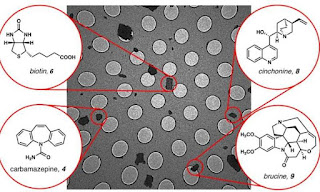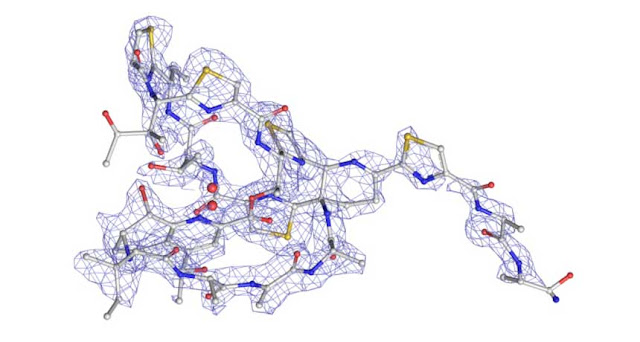With this new technique, chemical layout of smaller crystals can be determined swiftly with high precision
Using new technique to find
out chemical structure, two teams with independent operations worked out
structure of various compounds, antibiotics and other substances within few
hours. Where other older techniques could have taken from few months up to a year,
this new technique made it possible to obtain result within 30 mins to a day,
depending upon molecular structure.
Team which has published
its work in Angewandte Chemie, a journal of German
Chemical Society, on 16th October, comprised member of several
Swizz and German institutes. While other team included members from Howard
Huges Medical Institute and The University of California, published a paper
describing their work at ChemRxiv dated October, 17. By using similar technique, both teams tried to
observe the structure of over-the-counter medicines. |
| Four different compounds are identified from a heterogeneous mixture using microED data Credit: ChemRxiv |
“It’s important to know the
atom-by-atom structure of every substance that comes across molecular scientists.
Pharmaceutical companies confirm drugs’ composition and purity by understanding
chemical structure of drug. Most techniques used till date are like having a
fingerprint or an artist’s drawing, when what required is a photo” clarifies
coauthor of the ChemRxiv study an organic chemist Brian Stoltz,
Caltech.
 |
| Structure of Methylene blue derivative solved with electron crystallography (a) Structure of methylene blue derivative (b) Stacking of molecules in a crystal Credit: Angewandte Chemie |
Tim Gruene
of the Paul Scherrer Institute, Villigen, Switzerland and team split opened a
cold medication capsule comprising both active and inactive ingredients, paper
published in Angewandte Chemie reveals. The researchers resolved chemical
structure of acetaminophen from the heap of powder with the help of electron
crystallography. Using similar technique, Tim and his team determined the
structure of methylene blue derivative.
“That earlier solved structure isn’t exciting, but the fact that it
came from a mixture of several unalike molecules is” Gruene says. Talking about
applications of the newly developed technique, Gruene shared “This
technique surely will benefit crime labs examining trace samples. As
the method unambiguously confirms structures from smashed pills, it could also
be valuable in disputed drug patent cases".
 |
| NMR Spectroscopy |
Chemists these days have
two major options to distinguish the chemical structure of crystals.
First one is NMR or Nuclear Magnetic Resonance spectroscopy
which works upon distressing the magnetic behavior of atoms in a crystal followed
by analysis of their behavior to conclude the chemical structure of that crystal.
This technique comes with a drawback that it can be applied only to large
crystals with one side measuring minimum 50 micrometers. Such large crystals
are not easy to obtain and when obtained, finding their chemical structure is a
hard nut to crack as it involves large and complex calculations, applications of quantum chemistry along with whole
lot of time.
 |
| X-Ray Crystallography |
Second one is commonly used
technique now a days, X-Ray Crystallography. This method involves
firing of X-rays upon a crystal i.e. rocky substance made up of systematic
arrangement of molecules, and noticing the diffraction patterns obtained to
conclude the chemical structure. It also possesses same problem as NMR does.
Both teams in a new
approach, replaced X-rays with electrons beam to get the structure of very
small crystals. Study of respective
diffraction patterns caused when electrons were bombarded upon crystal, yielded the chemical
structure of crystal. “Electrons
bounce off matter whereas X-rays most of the time, pass through matter”
explains Tamir Gonen, an electron crystallography expert at UCLA and a coauthor
of paper published in ChemRxiv.
Citations and Sources:
Gruene, T. , Wennmacher, J. ., Zaubitzer, C. , Holstein, J. ., Heidler, J. , Fecteau-Lefebvre, A. , De Carlo, S. , Müller, E. , Goldie, K. ., Regeni, I. , Li, T. , Santiso-Quinones, G. , Steinfeld, G. , Handschin, S. , van Genderen, E. , van Bokhoven, J. ., Clever, G. . and Pantelic, R. (2018), Rapid structure determination of microcrystalline molecular compounds using electron diffraction. Angew. Chem. Int. Ed. . doi:10.1002/anie.201811318G.
Gruene, T. , Wennmacher, J. ., Zaubitzer, C. , Holstein, J. ., Heidler, J. , Fecteau-Lefebvre, A. , De Carlo, S. , Müller, E. , Goldie, K. ., Regeni, I. , Li, T. , Santiso-Quinones, G. , Steinfeld, G. , Handschin, S. , van Genderen, E. , van Bokhoven, J. ., Clever, G. . and Pantelic, R. (2018), Rapid structure determination of microcrystalline molecular compounds using electron diffraction. Angew. Chem. Int. Ed. . doi:10.1002/anie.201811318G.
G.
Jones, Christopher; Martynowycz, Michael W.; Hattne, Johan; Fulton, Tyler J.;
Stoltz, Brian M.; Rodriguez, Jose A.; et al. (2018): The CryoEM Method MicroED
as a Powerful Tool for Small Molecule Structure Determination. ChemRxiv.
Preprint. https://doi.org/10.26434/chemrxiv.7215332.v1





0 Comments: